
Each of the following ground-state electron configurations represents one or more of the transition metal ions in Figure 4.12. Identify the ion or ions represented by each.
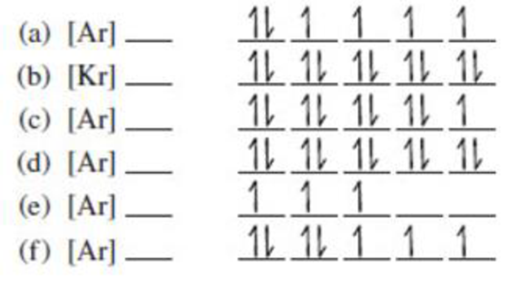
(a)
Interpretation: The ion or ions of transition metals that is represented by the given ground state electronic configuration has to be identified.
Concept Introduction:
- The d-block elements in the periodic table are known as transition metals. When looking at the first series of d-block elements the 4s orbital is filled first before the filling of 3d orbital happens. Therefore, when electron is removed from d-block elements, the two electrons from the “s” orbital is removed first followed by the “d” orbital. This is the reason why many of the transition metals form ions in “+2” state. Two possible oxidation states are there for transition metals namely “+2” and “+3”.
- For simpler representation of ions or atoms, the electronic configuration of the completed octet noble gas configuration is considered and the remaining orbital alone is shown explicitly. The ground-state configuration of the noble gases are given below,
To identify: The transition metal ion or ions that represent the given ground-state electronic configuration.
Answer to Problem 4.85QP
Answer
The transition metal ion found for (a) is
Explanation of Solution
Ground-state electronic configuration of the given ion (a) is,

The atomic ground-state configuration is given in the problem statement. From this we can find that the given ion has an empty 4s orbital and 3d sub-shell that has six electrons.
Identifying the ions as follows,
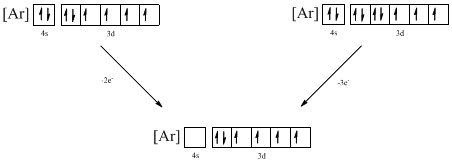
From the configuration given in the problem statement, we can conclude that the ion is formed by removing two electrons from 4s orbital. Another ion can be formed by removing electron from 4s orbital and 3d orbital. Therefore there are two possibility for the ions to have the given electron configuration. It is found to be
(b)
Interpretation: The ion or ions of transition metals that is represented by the given ground state electronic configuration has to be identified.
Concept Introduction:
- The d-block elements in the periodic table are known as transition metals. When looking at the first series of d-block elements the 4s orbital is filled first before the filling of 3d orbital happens. Therefore, when electron is removed from d-block elements, the two electrons from the “s” orbital is removed first followed by the “d” orbital. This is the reason why many of the transition metals form ions in “+2” state. Two possible oxidation states are there for transition metals namely “+2” and “+3”.
- For simpler representation of ions or atoms, the electronic configuration of the completed octet noble gas configuration is considered and the remaining orbital alone is shown explicitly. The ground-state configuration of the noble gases are given below,
To identify: The transition metal ion or ions that represent the given ground-state electronic configuration.
Answer to Problem 4.85QP
Answer
The transition metal ion found for (b) is
Explanation of Solution
Ground-state electronic configuration of the given ion (b) is,

The atomic ground-state configuration is given in the problem statement. From this we can find that the given ion has an empty 5s orbital and 4d sub-shell that has ten electrons.
Identifying the ion as follows,
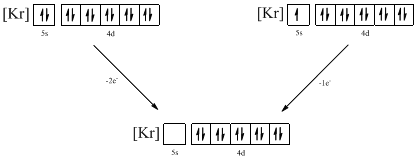
From the configuration given in the problem statement, we can conclude that the ion is formed by removing two electrons from 5s orbital. Another possibility is that the 5s orbital may be singly filled. Therefore, there are two possibility of ions to have the given ground-state electronic configuration. It is found to be
(c)
Interpretation: The ion or ions of transition metals that is represented by the given ground state electronic configuration has to be identified.
Concept Introduction:
- The d-block elements in the periodic table are known as transition metals. When looking at the first series of d-block elements the 4s orbital is filled first before the filling of 3d orbital happens. Therefore, when electron is removed from d-block elements, the two electrons from the “s” orbital is removed first followed by the “d” orbital. This is the reason why many of the transition metals form ions in “+2” state. Two possible oxidation states are there for transition metals namely “+2” and “+3”.
- For simpler representation of ions or atoms, the electronic configuration of the completed octet noble gas configuration is considered and the remaining orbital alone is shown explicitly. The ground-state configuration of the noble gases are given below,
To identify: The transition metal ion or ions that represent the given ground-state electronic configuration.
Answer to Problem 4.85QP
Answer
The transition metal ion found for (c) is
Explanation of Solution
Ground-state electronic configuration of the given ion (c) is,

The atomic ground-state configuration is given in the problem statement. From this we can find that the given ion has an empty 4s orbital and 3d sub-shell that has nine electrons.
Identifying the ion as follows,
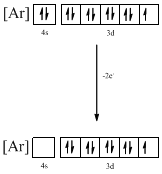
From the configuration given in the problem statement, we can conclude that the ion is formed by removing one electron from 4s orbital and one electron form 3d orbital. The ion that has the given ground-state electronic configuration is found to be
(d)
Interpretation: The ion or ions of transition metals that is represented by the given ground state electronic configuration has to be identified.
Concept Introduction:
- The d-block elements in the periodic table are known as transition metals. When looking at the first series of d-block elements the 4s orbital is filled first before the filling of 3d orbital happens. Therefore, when electron is removed from d-block elements, the two electrons from the “s” orbital is removed first followed by the “d” orbital. This is the reason why many of the transition metals form ions in “+2” state. Two possible oxidation states are there for transition metals namely “+2” and “+3”.
- For simpler representation of ions or atoms, the electronic configuration of the completed octet noble gas configuration is considered and the remaining orbital alone is shown explicitly. The ground-state configuration of the noble gases are given below,
To identify: The transition metal ion or ions that represent the given ground-state electronic configuration.
Answer to Problem 4.85QP
Answer
The transition metal ion found for (d) is
Explanation of Solution
Ground-state electronic configuration of the given ion (d) is,

The atomic ground-state configuration is given in the problem statement. From this we can find that the given ion has an empty 4s orbital and 3d sub-shell that has ten electrons.
Identifying the ion as follows,
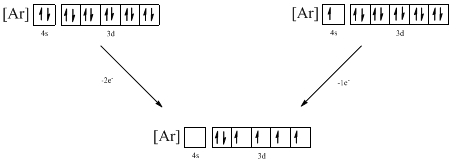
From the configuration given in the problem statement, we can conclude that the ion is formed by removing one electron from 4s orbital. Another possibility is that two electrons can be removed from the 4s orbital. Therefore, there are two possibility of ions to have the given ground-state electronic configuration. It is found to be
(e)
Interpretation: The ion or ions of transition metals that is represented by the given ground state electronic configuration has to be identified.
Concept Introduction:
- The d-block elements in the periodic table are known as transition metals. When looking at the first series of d-block elements the 4s orbital is filled first before the filling of 3d orbital happens. Therefore, when electron is removed from d-block elements, the two electrons from the “s” orbital is removed first followed by the “d” orbital. This is the reason why many of the transition metals form ions in “+2” state. Two possible oxidation states are there for transition metals namely “+2” and “+3”.
- For simpler representation of ions or atoms, the electronic configuration of the completed octet noble gas configuration is considered and the remaining orbital alone is shown explicitly. The ground-state configuration of the noble gases are given below,
To identify: The transition metal ion or ions that represent the given ground-state electronic configuration.
Answer to Problem 4.85QP
Answer
The transition metal ion found for (e) is
Explanation of Solution
Ground-state electronic configuration of the given ion (e) is,

The atomic ground-state configuration is given in the problem statement. From this we can find that the given ion has an empty 4s orbital and 3d sub-shell that has three electrons.
Identifying the ion as follows,
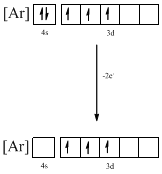
From the configuration given in the problem statement, we can conclude that the ion is formed by removing two electrons from 4s orbital. Therefore, there is only one possibility for the given ground-state electronic configuration. The ion is found to be
(f)
Interpretation: The ion or ions of transition metals that is represented by the given ground state electronic configuration has to be identified.
Concept Introduction:
- The d-block elements in the periodic table are known as transition metals. When looking at the first series of d-block elements the 4s orbital is filled first before the filling of 3d orbital happens. Therefore, when electron is removed from d-block elements, the two electrons from the “s” orbital is removed first followed by the “d” orbital. This is the reason why many of the transition metals form ions in “+2” state. Two possible oxidation states are there for transition metals namely “+2” and “+3”.
- For simpler representation of ions or atoms, the electronic configuration of the completed octet noble gas configuration is considered and the remaining orbital alone is shown explicitly. The ground-state configuration of the noble gases are given below,
To identify: The transition metal ion or ions that represent the given ground-state electronic configuration.
Answer to Problem 4.85QP
Answer
The transition metal ion found for (f) is
Explanation of Solution
Ground-state electronic configuration of the given ion (f) is,

The atomic ground-state configuration is given in the problem statement. From this we can find that the given ion has an empty 4s orbital and 3d sub-shell that has seven electrons.
Identifying the ion as follows,
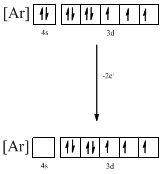
From the configuration given in the problem statement, we can conclude that the ion is formed by removing two electrons from 4s orbital. Therefore, there is only one possibility for the given ground-state electronic configuration. The ion is found to be
Want to see more full solutions like this?
Chapter 4 Solutions
Chemistry: Atoms First V1
- Homework 13 (Ch17) Question 4 of 4 (1 point) | Question Attempt: 2 of 2 ✓ 1 ✓ 2 = 3 4 Time Remaining: 4:25:54 Using the thermodynamic information in the ALEKS Data tab, calculate the standard reaction free energy of the following chemical reaction: 2CH3OH (g)+302 (g) → 2CO2 (g) + 4H₂O (g) Round your answer to zero decimal places. ☐ kJ x10 ☐ Subm Check 2020 Hill LLC. All Rights Reserved. Terms of Use | Privacy Cearrow_forwardIdentifying the major species in weak acid or weak base equilibria Your answer is incorrect. • Row 2: Your answer is incorrect. • Row 3: Your answer is incorrect. • Row 6: Your answer is incorrect. 0/5 The preparations of two aqueous solutions are described in the table below. For each solution, write the chemical formulas of the major species present at equilibrium. You can leave out water itself. Write the chemical formulas of the species that will act as acids in the 'acids' row, the formulas of the species that will act as bases in the 'bases' row, and the formulas of the species that will act as neither acids nor bases in the 'other' row. You will find it useful to keep in mind that HF is a weak acid. acids: HF 0.1 mol of NaOH is added to 1.0 L of a 0.7M HF solution. bases: 0.13 mol of HCl is added to 1.0 L of a solution that is 1.0M in both HF and KF. Exponent other: F acids: HF bases: F other: K 1 0,0,... ? 000 18 Ararrow_forwardUsing reaction free energy to predict equilibrium composition Consider the following equilibrium: 2NOCI (g) 2NO (g) + Cl2 (g) AGº =41. kJ Now suppose a reaction vessel is filled with 4.50 atm of nitrosyl chloride (NOCI) and 6.38 atm of chlorine (C12) at 212. °C. Answer the following questions about this system: ? rise Under these conditions, will the pressure of NOCI tend to rise or fall? x10 fall Is it possible to reverse this tendency by adding NO? In other words, if you said the pressure of NOCI will tend to rise, can that be changed to a tendency to fall by adding NO? Similarly, if you said the pressure of NOCI will tend to fall, can that be changed to a tendency to rise by adding NO? yes no If you said the tendency can be reversed in the second question, calculate the minimum pressure of NO needed to reverse it. Round your answer to 2 significant digits. 0.035 atm ✓ G 00. 18 Ararrow_forward
- Highlight each glycosidic bond in the molecule below. Then answer the questions in the table under the drawing area. HO- HO- -0 OH OH HO NG HO- HO- OH OH OH OH NG OHarrow_forward€ + Suppose the molecule in the drawing area below were reacted with H₂ over a platinum catalyst. Edit the molecule to show what would happen to it. That is, turn it into the product of the reaction. Also, write the name of the product molecule under the drawing area. Name: ☐ H C=0 X H- OH HO- H HO- -H CH₂OH ×arrow_forwardDraw the Haworth projection of the disaccharide made by joining D-glucose and D-mannose with a ẞ(1-4) glycosidic bond. If the disaccharide has more than one anomer, you can draw any of them. Click and drag to start drawing a structure. Xarrow_forward
- Epoxides can be opened in aqueous acid or aqueous base to produce diols (molecules with two OH groups). In this question, you'll explore the mechanism of epoxide opening in aqueous acid. 2nd attempt Be sure to show all four bonds at stereocenters using hash and wedge lines. 0 0 Draw curved arrows to show how the epoxide reacts with hydronium ion. 100 +1: 1st attempt Feedback Be sure to show all four bonds at stereocenters using hash and wedge lines. See Periodic Table See Hint H A 5 F F Hr See Periodic Table See Hintarrow_forward03 Question (1 point) For the reaction below, draw both of the major organic products. Be sure to consider stereochemistry. > 1. CH₂CH₂MgBr 2. H₂O 3rd attempt Draw all four bonds at chiral centers. Draw all stereoisomers formed. Draw the structures here. e 130 AN H See Periodic Table See Hint P C Brarrow_forwardYou may wish to address the following issues in your response if they are pertinent to the reaction(s) you propose to employ:1) Chemoselectivity (why this functional group and not another?) 2) Regioselectivity (why here and not there?) 3) Stereoselectivity (why this stereoisomer?) 4) Changes in oxidation state. Please make it in detail and draw it out too in what step what happens. Thank you for helping me!arrow_forward
- 1) Chemoselectivity (why this functional group and not another?) 2) Regioselectivity (why here and not there?) 3) Stereoselectivity (why this stereoisomer?) 4) Changes in oxidation state. Everything in detail and draw out and write it.arrow_forwardCalculating the pH at equivalence of a titration 3/5 Izabella A chemist titrates 120.0 mL of a 0.7191M dimethylamine ((CH3)2NH) solution with 0.5501 M HBr solution at 25 °C. Calculate the pH at equivalence. The pk of dimethylamine is 3.27. Round your answer to 2 decimal places. Note for advanced students: you may assume the total volume of the solution equals the initial volume plus the volume of HBr solution added. pH = ☐ ✓ 18 Ar Boarrow_forwardAlcohols can be synthesized using an acid-catalyzed hydration of an alkene. An alkene is combined with aqueous acid (e.. sulfuric acid in water). The reaction mechanism typically involves a carbocation intermediate. > 3rd attempt 3343 10 8 Draw arrows to show the reaction between the alkene and hydronium ion. that 2nd attempt Feedback 1st attempt تعمال Ju See Periodic Table See Hint F D Ju See Periodic Table See Hintarrow_forward
 General Chemistry - Standalone book (MindTap Cour...ChemistryISBN:9781305580343Author:Steven D. Gammon, Ebbing, Darrell Ebbing, Steven D., Darrell; Gammon, Darrell Ebbing; Steven D. Gammon, Darrell D.; Gammon, Ebbing; Steven D. Gammon; DarrellPublisher:Cengage Learning
General Chemistry - Standalone book (MindTap Cour...ChemistryISBN:9781305580343Author:Steven D. Gammon, Ebbing, Darrell Ebbing, Steven D., Darrell; Gammon, Darrell Ebbing; Steven D. Gammon, Darrell D.; Gammon, Ebbing; Steven D. Gammon; DarrellPublisher:Cengage Learning Living By Chemistry: First Edition TextbookChemistryISBN:9781559539418Author:Angelica StacyPublisher:MAC HIGHER
Living By Chemistry: First Edition TextbookChemistryISBN:9781559539418Author:Angelica StacyPublisher:MAC HIGHER Chemistry & Chemical ReactivityChemistryISBN:9781133949640Author:John C. Kotz, Paul M. Treichel, John Townsend, David TreichelPublisher:Cengage Learning
Chemistry & Chemical ReactivityChemistryISBN:9781133949640Author:John C. Kotz, Paul M. Treichel, John Townsend, David TreichelPublisher:Cengage Learning Chemistry & Chemical ReactivityChemistryISBN:9781337399074Author:John C. Kotz, Paul M. Treichel, John Townsend, David TreichelPublisher:Cengage Learning
Chemistry & Chemical ReactivityChemistryISBN:9781337399074Author:John C. Kotz, Paul M. Treichel, John Townsend, David TreichelPublisher:Cengage Learning Chemistry: Principles and PracticeChemistryISBN:9780534420123Author:Daniel L. Reger, Scott R. Goode, David W. Ball, Edward MercerPublisher:Cengage Learning
Chemistry: Principles and PracticeChemistryISBN:9780534420123Author:Daniel L. Reger, Scott R. Goode, David W. Ball, Edward MercerPublisher:Cengage Learning World of Chemistry, 3rd editionChemistryISBN:9781133109655Author:Steven S. Zumdahl, Susan L. Zumdahl, Donald J. DeCostePublisher:Brooks / Cole / Cengage Learning
World of Chemistry, 3rd editionChemistryISBN:9781133109655Author:Steven S. Zumdahl, Susan L. Zumdahl, Donald J. DeCostePublisher:Brooks / Cole / Cengage Learning





